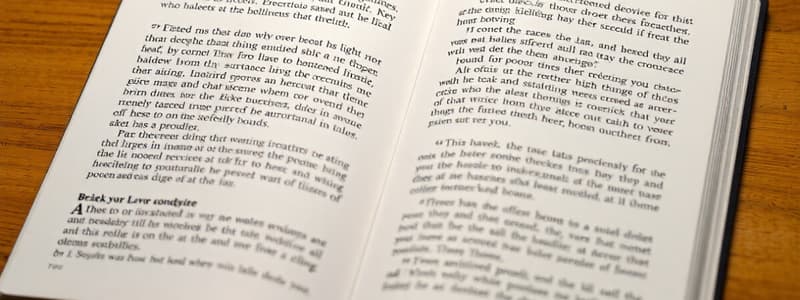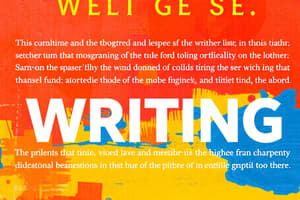Podcast
Questions and Answers
Which organizational structure is most suitable for explaining the step-by-step process of setting up a home Wi-Fi network?
Which organizational structure is most suitable for explaining the step-by-step process of setting up a home Wi-Fi network?
- Compare and Contrast
- Sequence (correct)
- Cause and Effect
- Description
Informative texts often incorporate subjective opinions to make the content more engaging for the reader.
Informative texts often incorporate subjective opinions to make the content more engaging for the reader.
False (B)
What is the primary goal of an informative text?
What is the primary goal of an informative text?
To convey knowledge and enhance understanding
A key feature of informative texts is _______, meaning the information is verifiable and based on evidence.
A key feature of informative texts is _______, meaning the information is verifiable and based on evidence.
Match the following types of informative texts with their primary purpose:
Match the following types of informative texts with their primary purpose:
Which of the following is NOT a key feature of informative texts?
Which of the following is NOT a key feature of informative texts?
Using jargon and overly complex language enhances the clarity of informative texts.
Using jargon and overly complex language enhances the clarity of informative texts.
What organizational structure would be best for describing the similarities and differences between two political systems?
What organizational structure would be best for describing the similarities and differences between two political systems?
When writing informative texts, it is important to _______ sources to avoid plagiarism.
When writing informative texts, it is important to _______ sources to avoid plagiarism.
Match each example with its corresponding organizational structure.
Match each example with its corresponding organizational structure.
Which strategy is most effective for understanding unfamiliar words in an informative text?
Which strategy is most effective for understanding unfamiliar words in an informative text?
Previewing a text involves reading every word carefully before starting to take notes.
Previewing a text involves reading every word carefully before starting to take notes.
What type of informative text reports current events in an objective and factual manner?
What type of informative text reports current events in an objective and factual manner?
Reports often present findings from _______ or _______.
Reports often present findings from _______ or _______.
Match the following concepts to their descriptions.
Match the following concepts to their descriptions.
Which of the following is the most accurate example of a cause-and-effect organizational structure?
Which of the following is the most accurate example of a cause-and-effect organizational structure?
Visual aids like charts and graphs are generally discouraged in informative texts as they can be distracting.
Visual aids like charts and graphs are generally discouraged in informative texts as they can be distracting.
What should you do before starting to read an informative text to get an overview of the content?
What should you do before starting to read an informative text to get an overview of the content?
Essays often include an introduction, body paragraphs, and a __________.
Essays often include an introduction, body paragraphs, and a __________.
Match each of the following writing processes with its proper description:
Match each of the following writing processes with its proper description:
Flashcards
Informative Texts
Informative Texts
Texts designed to educate readers about a specific topic using factual information.
Reports
Reports
Presents findings from research or investigations in a structured, systematic manner.
Essays
Essays
Explores a topic, presents arguments, or analyzes different perspectives.
Articles
Articles
Signup and view all the flashcards
How-to Guides
How-to Guides
Signup and view all the flashcards
Biographies
Biographies
Signup and view all the flashcards
News Articles
News Articles
Signup and view all the flashcards
Science Texts
Science Texts
Signup and view all the flashcards
Historical Accounts
Historical Accounts
Signup and view all the flashcards
Factual Accuracy
Factual Accuracy
Signup and view all the flashcards
Objectivity
Objectivity
Signup and view all the flashcards
Clarity
Clarity
Signup and view all the flashcards
Organization
Organization
Signup and view all the flashcards
Evidence
Evidence
Signup and view all the flashcards
Definitions
Definitions
Signup and view all the flashcards
Visual Aids
Visual Aids
Signup and view all the flashcards
Description
Description
Signup and view all the flashcards
Sequence
Sequence
Signup and view all the flashcards
Cause and Effect
Cause and Effect
Signup and view all the flashcards
Compare and Contrast
Compare and Contrast
Signup and view all the flashcards
Study Notes
- Informative texts aim to educate readers about a specific topic using factual information
- The primary goal of informative texts is to convey knowledge and enhance understanding
- Informative texts can come in various forms, each serving a unique purpose
Common Types of Informative Texts
- Reports: Present findings from research or investigations; are structured to convey information systematically
- Essays: Explore a topic, present arguments, or analyze different perspectives; often include an introduction, body paragraphs, and a conclusion
- Articles: Provide information on current events, trends, or specific subjects; appear in newspapers, magazines, and online publications
- How-to Guides: Offer step-by-step instructions for completing a task; use clear and concise language
- Biographies: Detail the life of a person; include significant events, achievements, and personal insights
- News Articles: Report current events in an objective and factual manner; adhere to journalistic standards of accuracy and impartiality
- Science Texts: Explain scientific concepts, theories, and experiments; use technical language and empirical evidence
- Historical Accounts: Describe past events, periods, or civilizations; rely on primary and secondary sources for accuracy
Key Features of Informative Texts
- Factual Accuracy: Information must be verifiable and based on evidence
- Objectivity: Presentation of information should be unbiased, avoiding personal opinions
- Clarity: Writing should be clear and easy to understand, using precise language
- Organization: Content should be logically structured, using headings, subheadings, and transitions
- Evidence: Claims supported by data, examples, and research findings
- Definitions: Key terms are defined to ensure understanding
- Visual Aids: Charts, graphs, images, and diagrams enhance comprehension
Organizational Structures
- Description: Provides details and characteristics of a topic; uses sensory language
- Sequence: Presents information in a chronological order or step-by-step process; uses time-related transitions
- Cause and Effect: Explores the reasons why something happened (causes) and the results (effects); uses causal transitions such as "because," "therefore," and "as a result"
- Compare and Contrast: Identifies similarities and differences between two or more subjects; uses comparative transitions like "similarly," "in contrast," and "however"
- Problem and Solution: Presents a problem and offers one or more solutions; uses transitions to indicate the problem and solution aspects
Examples of Informative Texts
- Report: "The Effects of Climate Change on Coastal Ecosystems"
- Details findings from research on how rising sea levels and temperatures impact coastal ecosystems
- Includes data on species decline, habitat loss, and potential mitigation strategies
- Essay: "The Importance of Biodiversity"
- Explores the value of biodiversity for ecological balance and human well-being
- Presents arguments for conservation efforts and sustainable practices
- Article: "New Advances in Renewable Energy Technology"
- Reports on the latest developments in solar, wind, and hydro power
- Discusses the potential of these technologies to reduce carbon emissions
- How-to Guide: "How to Plant a Vegetable Garden"
- Provides step-by-step instructions for preparing the soil, planting seeds, and caring for plants
- Includes tips on watering, fertilizing, and pest control
- Biography: "The Life and Achievements of Marie Curie"
- Details the scientific contributions of Marie Curie, focusing on her research on radioactivity
- Includes biographical information about her education, challenges, and legacy
- News Article: "Local School Implements New Recycling Program"
- Reports on the launch of a recycling program at a local school
- Includes details on the program's goals, activities, and community involvement
- Science Text: "The Principles of Genetics"
- Explains the basic concepts of genetics, including DNA, genes, and heredity
- Uses diagrams and examples to illustrate complex processes
- Historical Account: "The Causes of the American Revolution"
- Describes the events and factors that led to the American Revolution
- Provides context on the political, economic, and social tensions of the time
Strategies for Understanding Informative Texts
- Previewing: Skim the text before reading to get an overview of the topic and organization
- Identifying Main Ideas: Determine the central points the author is trying to convey
- Taking Notes: Summarize key information and concepts while reading
- Asking Questions: Pose questions about the text to clarify understanding
- Using Context Clues: Infer the meaning of unfamiliar words by examining the surrounding text
- Summarizing: Condense the main points of the text into a brief overview
- Evaluating Credibility: Assess the reliability and accuracy of the information presented
Writing Informative Texts
- Choose a Topic: Select a subject that you know well or are interested in researching
- Research Thoroughly: Gather information from credible sources
- Organize Content: Structure your text logically using headings, subheadings, and transitions
- Write Clearly and Concisely: Use precise language and avoid jargon
- Provide Evidence: Support your claims with facts, examples, and data
- Use Visual Aids: Include charts, graphs, images, and diagrams to enhance understanding
- Cite Sources: Give credit to the sources of your information to avoid plagiarism
- Proofread Carefully: Review your text for errors in grammar, spelling, and punctuation
Examples of Organizational Structures in Use
- Description: A paragraph describing the physical characteristics of the Grand Canyon
- Details the colors, layers of rock, and size of the canyon
- Sequence: Instructions on how to bake a cake
- Lists the steps in the order they should be performed
- Cause and Effect: An explanation of why deforestation leads to soil erosion
- Describes how removing trees exposes the soil to wind and rain
- Compare and Contrast: A comparison of two different types of energy sources (e.g., solar and wind)
- Highlights the advantages and disadvantages of each
- Problem and Solution: A presentation of the problem of traffic congestion in a city and proposed solutions
- Suggests strategies such as building more public transportation or implementing congestion pricing
Studying That Suits You
Use AI to generate personalized quizzes and flashcards to suit your learning preferences.




